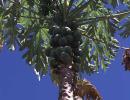 |
Papaya
Scientific name:
Carica papaya
Family:
Violales: Caricaceae
Local names:
English: Pawpaw; Swahili: papayu
Pests and Diseases: Aphids
Broad mite
Damping-off and root rot
False spider mite
Fruit flies
Mealybugs
Papaya ringspot potyvirus
Powdery mildew
Ripe fruit rots
Root-knot nematodes
Snails (Giant East African Snail)
Spider mites
Systates weevil
Whiteflies
Anthracnose, Black spot, Black rust, Leaf spot, Stem rot, Mealybugs
|
 |
| Geographical Distribution of Papaya in Africa |
Carpaine, an alkaloid present in papaya, can be used as a heart depressant, amoebicide and diuretic. In some countries papaya is grown in sizeable plantations for the extraction of papain, an enzyme present in the latex, collected mainly from the green fruit. Papain has varied uses in the beverage, food and pharmaceutical industries: in chill-proofing beer, tenderizing meat, drug preparations for digestive ailments and treatment of gangrenous wounds. It is also used in treating hides, degumming silk and softening wool.
There are 3 groups of papayas distinguished on the basis of their flowers: Female (pistillate), male (staminate) and hermaphrodite (bear both male and female flowers). These groups are only distinguishable at flowering stage. Fruits from female flowered trees are usually sweeter and of more round shape than fruits from hermaphrodite trees.
Nutritive Value per 100 g of edible Portion
| Raw or Cooked Papaya | Food Energy (Calories / %Daily Value*) |
Carbohydrates (g / %DV) |
Fat (g / %DV) |
Protein (g / %DV) |
Calcium (g / %DV) |
Phosphorus (mg / %DV) |
Iron (mg / %DV) |
Potassium (mg / %DV) |
Vitamin A (I.U) |
Vitamin C (I.U) |
Vitamin B 6 (I.U) |
Vitamin B 12 (I.U) |
Thiamine (mg / %DV) |
Riboflavin (mg / %DV) |
Ash (g / %DV) |
| Papaya raw | 39.0 / 2% | 9.8 / 3% | 0.1 / 0% | 0.6 / 1% | 24.0 / 2% | 5.0 / 1% | 0.1 / 1% | 257 / 7% | 1094 IU / 22% | 61.8 / 103% | 0.0 / 1% | 0.0 / 0% | 0.0 / 2% | 0.0 / 2% | 0.6 |
Papaya grows best in light, well-drained soils rich in organic matter with soil pH of 6.0-6.5. It can tolerate any kind of soil provided it is well-drained and not too dry. The roots are very sensitive to waterlogging and even short periods of flooding can kill the plants.
Papaya needs adequate drainage and is often planted on mounds or ridges. Transplants must be watered regularly until they are established. Field spacings are in the order of 3 x 2 m to 2.50 x 1.60 m, giving densities of 1667 and 2500 plants/ha respectively. The same densities are obtained by planting in double rows spaced (3.25+1.75) x 2.40 m or (2.50+1.50) x 2 m. Thinning to one female or one hermaphrodite plant per hill is done when the plants reach the flowering stage. In the absence of hermaphrodite plants, 1 male plant per 25 - 100 female plants is retained as pollinator.
Papaya plants grown from seed produce fruits of different shapes, sizes, colour and even taste. Vegetative propagation of papaya provides a solution to most of these problems. The clone is selected for higher productivity and good quality fruits besides agronomic qualities such as dwarfness for easy harvesting and good resistance to diseases. Propagation of papaya using tissue culture is fast gaining popularity, mainly because tissue culture has numerous advantages over other conventional methods of propagation. Tissue culture facilitates rapid production of disease free plants. In Kenya such plants are available from Kenya Agricultural Research Institute (KARI), Thika as well as several private companies.
Planting holes of 60 x 60 cm and at least 50 cm deep are prepared with 1 bucket of compost and a handful of rock phosphate is mixed in with the dug out soil and returned around the plant. Firm the soil and water liberally and add mulch around the young plant.
Major varieties include:
- 'Honey Dew'. This is an Indian variety of medium height that produces oval juicy medium size fruit.
- 'Kiru'. Is a Tanzanian variety that produces large fruits. It is a high yielder of papain.
- 'Mountain'. Originally the name for a variety grown at high altitudes with very small fruits only suitable for jam and preserves. Now the name is also used for a medium size variety with good fresh consumption qualities such as firm sweet tasting yellow flesh.
- 'Solo'. It is a Hawaiian variety that produces small round very sweet fruits with uniform size and shape. It is hermaphroditic.
- 'Sunrise Solo'. Hawaiin variety that produces smooth pear shaped fruit of high quality, weighing 400 to 650 g. The flesh is reddish orange. This variety is high yielding.
- 'Sunset': Hawaiian variety with red flesh and having same characteristics as 'Solo'
- 'Waimanalo'. Hawaiian variety that produces smooth, shiny round fruits with short neck and is of high quality. The flesh is orange yellow, thick, sweet and firm.
Most of commercial varieties grown in Kenya are derived from Hawaii. A few are from India and some known as 'Mountain varieties' whose origin / source is a rather not explained. None of these have been reported to have resistance to Phytophthora palmivora. However, information available claims that Hawaiian lines such as 'Waimanalo 23', 'Waimanalo 24' and 'Line 40' exhibit resistance to P. palmivora.
Another serious disease problem with papaya is papaya ring spot virus. However, according to a recent report by PIP COLEACP (www.coleacp.org/en), there are no commercial papaya varieties, except for transgenic, which are tolerant or resistant to papaya ring spot virus or bunchy top virus.
The appearance of traces of yellow colour on the fruit indicates that it is ready for harvesting. Fruits harvested early have longer post harvest life, but give abnormal taste and flavour. The fruits also tend to shrivel and suffer chilling injuries when refrigerated. The fruit is twisted until the stalk snaps off or cut with a sharp knife. Yields per tree vary from 30 to 150 fruits annually, giving 35 to 50 tons of fruit per ha per year. A papaya plantation can be productive for over 10 years but the economical period is only the first 3 to 4 years. It is therefore advisable to renew the plantation every 4 years.
For papain production, latex is collected by tapping the green unripe fruit. Four longitudinal incisions, skin-deep and 2 to 3 cm apart are made with a sharp, non-corrosive rod (glass, plastic or horn). Latex is collected in a clean glass or porcelain container and dried, or a canvas covered tray fixed onto the trunk of the tree. The latex is later scraped off the canvas with a wooden scraper and dried. Fruits may be tapped once a week, until they show signs of ripening. The operation is best done early in the morning (before 10:00) because the latex flows slowly in hot weather. Tapping results in ugly scars on the fruit, although quality is unaffected. Tapped fruit can be processed or used as animal feed. The papain producing trees are productive for 2 to 3 years, with the first 2 years being the most productive. If kept longer production is uneconomical.
Fruit flies
Two species of fruit flies have been recorded from papaya in East Africa, namely Bactrocera invadens and Ceratitis rosa (personal communication S. Ekesi, AFFI, icipe). The flies usually deposit their eggs in ripe fruit. Some fruit flies lay eggs on green pawpaw, but most of the eggs die due to the latex secreted when fruits are punctured by females while laying eggs. Developing larvae cause rotting of ripening fruits. Fruit flies are a major concern of papaya-importing countries.
- Fruit should be harvested at the mature green stage.
- Over-ripe and infested fruit should be buried.
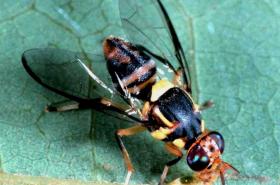
Fruit fly Bactrocera invadens
© R. C. Copeland, icipe
Spider mites
Several species of mites damage papaya (personal communication, M. Knapp, ICIPE):
* Spider mites (Tetranychus spp., Eutetranychus spp. and Oligonychus gossypii)
* The false spider mite (Brevipalpus phoenicis)
* The broad mite (Polyphagotarsonemus latus)
The spider mites suck the plant sap, leading to poor plant growth and blemish on the fruit. Infested leaves show yellow patches on the upper surface, particularly between main veins and midrib. Feeding by mites causes scarring and discolouration of fruit, and reduced fruit size affecting its market value. Infestations usually begin on the older leaves and the spreads to the younger growth. Serious infestations occur during long dry periods. Broad mites attack mainly the terminal buds; they feed on the young leaves as they emerge from the growing point. Affected leaves are thick and brittle, with down curled edges. Severe infestations inhibit new stem growth, with consequent reduction in fruit production.
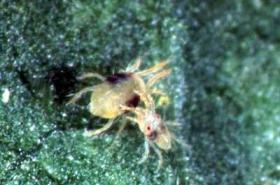
Two-spotted spider mite. The adult female is 0.6 mm long. The male is smaller.
© Warwick HRI, University of Warwick.
The false spider mite (Brevipalpus phoenicis)
The adults are about 0.1 mm. It usually feeds on the trunk below the level where the bottom whorl of leaves is attached. The mites move upward on the trunk and outward onto the leaves and fruit as the population increases, leaving a large, conspicuous, damaged area behind them. The affected area becomes raised and blister-like. Later the affected tissue dries up, dies and becomes discoloured, forming a large and continuous callous area, light brown and scaly and/or scabby.
Damage by feeding on young papaya fruits is manifested by sunken areas. Sometimes feeding by the mite causes a copious outflow of a milky white liquid that mars the appearance of the fruits. Under heavy mite infestations, the papaya stem, which normally remains green for a long time, becomes brownish and corky in appearance, and has a spindly growth (Martin Kessing and Mau, 1992; CABI Compendium, 2000).
- Natural enemies, like predatory mites, often provide adequate control of the false spider mite.
- Wettable sulphur sprays can be used in case of heavy infestations (note that sulphur has phytotoxic effects when used during hot weather).
The broad mite (Polyphagotarsonemus latus)
Broad mites are tiny (0.1-0.2 mm long) cannot be seen with the naked eye, and are even difficult to detect with a hand lens. In addition, they often disappear before the damage is noticed. Therefore an attack by broad mites is usually detected by the symptoms of damage. Broad mite attacks mainly the growing point and the underside of young leaves causing hardening and distortion. Severe infestations inhibit new stem growth, with consequent reduction in fruit production. Broad mite damage may be confused with injury caused by some herbicides because in both cases the leaves become claw-like with prominent veins. Grey or bronze scar tissue between the veins on the underside of the leaves distinguishes mite from herbicide damage. For early detection of damage inspect the growing point of the tree regularly. This is important to allow control the pest before serious distortion of terminal growth occurs.
- Natural enemies, in particular predatory mites often provide adequate control of mites. Therefore, the use of acaricides or insecticides that also kill mites should be restricted.
- Sulphur, insecticidal oils or soaps are effective against mites. However, sulphur is reported to be toxic to predatory mites.
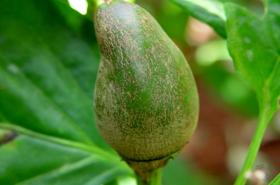
Broad mite damage (here on chili)
© A.M. Varela, icipe
The cotton aphid (Aphis gossypii) and the green peach aphid (Myzus persicae)
These are the most important aphids in papaya growing. These insects suck sap from young leaves and flowers and may weaken the plants. However, this type of damage is usually of little importance. Their importance as pests is mainly due to their ability to transmit virus diseases, for instance the papaya ring spot virus and the papaya mosaic virus. Few aphids are enough to transmit mosaic virus. These aphids are also found on other crops such as cucurbits, potatoes and tobacco.
- Avoid planting these crops near papaya fields.
- Removing alternative hosts and the presence of natural predators can effectively reduce aphid populations.
- Monitoring and control of aphids in the nursery is important.
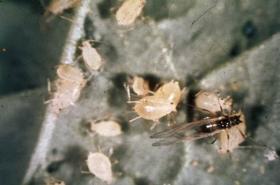
Cotton aphid (Aphis gossypii) is a small aphid. Adults range from just under 1-1.5 mm in body length.
© Mississippi State University Archive, Mississippi State University, Bugwood.org

Cotton aph…

Green peac…
The systates weevil (Systates spp.)
This is a very common weevil in East Africa. It attacks many crops and ornamental plants. The adult is a black weevil, about 12 mm long with a swollen, rounded abdomen, and long, thin, elbowed antenna. It is active at night, feeding on the edges of leaves producing a characteristic indentations. During the day it hides in the mulch, at the base of plants or in loose soil near plants. They feed on a wide range of crops and wild plants. They can be a problem to young papaya plants when present in large numbers.
- Hand picking and destruction is possible.
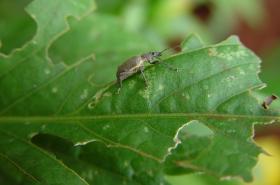
The systates weevil (Systates spp.) on papaya. The weevil feeds on leaves, making characteristic notch-like indentations to the leaf margin
© A.M. Varela, icipe
Root-knot nematodes (Meloidogyne incognita)
Feeding root-knot nematodes cause root swellings or root galls, resulting in yellowing and premature abscission of the leaves. Infestation by nematodes reduces growth and yield. In nurseries, severely infested seedlings wilt and die.
- It is important to use clean land, and not to replant papaya in the same field.
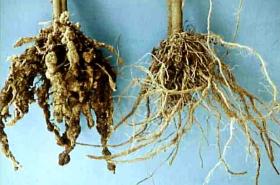
Root-knot nematodes (Meloidogyne incognita / M. javanica) Roots of severely attacked (left) and healthy plant (right). Affected plants are normally stunted and eventually wilt and die. The most characteristic symptom is formation of root galls (knots) and these can be seen with the naked eye. Affected roots rot.
© A. M. Varela, icipe
Damping-off and root rot
These are caused by the soil-borne fungi Phytophthora parasitica, P. palmivora and Pythium aphanidermatum. Phytophthora and Pythium also occur in the orchard, causing root rot.
Stem and fruit rots are produced on papaya. Infected young fruits develop water-soaked lesions that exude milky latex. These fruits may eventually shrivel and fall off the trunk. Infected trees show yellowing of leaves, which later collapse and hang limply around the trunk before falling. Small roots are generally absent and large ones show a soft, wet decay extending towards the trunk. At that stage, the lateral roots and taproots are entirely destroyed and a foul odour often emanates from diseased trees. Stem cankers, which develop most frequently in the top of the stem where the fruit is borne, induce fruit and leaf fall. These fungi may also cause trunk rot of mature trees. Infected trees eventually die.
Plants are susceptible at all ages but roots of young seedlings are most susceptible.
- Ensuring good soil aeration.
- Good drainage and hygiene are important to control these fungi in the orchard as well as in the nursery.
- If possible do not replant pawpaw on the same land.
- Copper based fungicide treatments at the very beginning of first symptoms can reduce fruit rots. However papaya fruits are very senstive to copper. For more information on copper click here.
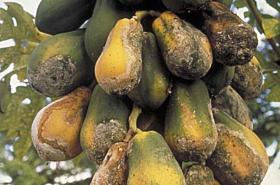
White fungal crusts of white mycelium associated with fruit rot of papaya (Phytophthora palmivora).
© Courtesy EcoPort (http://www.ecoport.org): Grahame Jackson
Ripe fruit rots
Several fungal pathogens are involved in fruit decay. They include Colletotrichum gloeosporioides (Glomorella cingulata), Alternaria tenuis, Phomopsis caricae-papayae and Ascochyta caricae.
Symptoms first appear as brown, superficial discolourations of the skin. These develop into circular, more or less sunken spots and tend to occur in a group on the outer exposed side of the fruit and often join to form a large rotted area extending deep into the flesh. The fungi causing ripe fruit rots live on dying leaf stalks and produce spores, which spread to the fruit particularly during wet weather.
Several of these fungi, especially, Colletotrichum gloeosporioides, may infect green fruit and remain dormant in the tissues until ripening when they develop rapidly. They constitute a big post-harvest problem especially during transport and storage.
- A 20-minute hot-water dip at 45°C reduces post-harvest decay.
- Spray fruit with hot water at 54°C for 3 minutes.
- Destroy rotten fruit.
- Practise early harvesting.
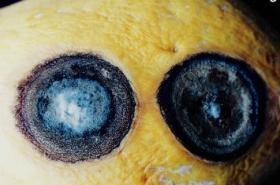
Ripe fruit rot on Papaya
© Illustration courtesy of http://www.padil.gov.au use with permission.
Powdery mildew (Oidium caricae; Sphaerotheca humili)
Young crown leaves show light green patches covered by a white powdery growth. Fruits develop circular, white patches on the surface. As the fruits develop, the white mould disappears leaving grey-scarred areas. The disease is particularly severe on immature tissue. The white mildew produced on leaves and fruits, contains large numbers of spores, which are spread to adjacent trees by wind and rain.
- Collect and destroy fallen diseased leaves.
- Spray wettable sulphur. However, sulphur should not be applied when it is very hot as it may cause leaf scorch. Alternatives to the use of sulphur are baking powder, neem extracts and white mineral oil plus .soap solution.
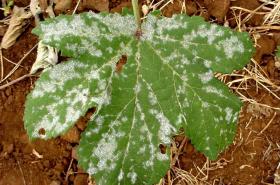
Powdery mildew (here on upper surface of an okra leaf).
© A. M. Varela, icipe
Papaya ringspot potyvirus
It is a devastating virus disease. In Africa, it occurs in Kenya, Nigeria, Tanzania and Uganda. Initially, the disease appears as oil streaks on stems and petioles and as it progresses, mottling of leaves becomes evident. Severely infected plants do not flower and die young. Infected fruits develop characteristic line patterns, which form rings and remain green when fruits ripen. The virus is spread by aphids and it is also mechanically transmitted.
- Plant in isolation.
- Remove and destroy infected plants.
- Avoid interplanting with cucurbits, which are also a host of PRSV.
- Use tolerant cultivars.
- Papaya mosaic potexvirus is another virus disease transmitted by aphids. Therefore, control aphids as soon as they are visible with soap sprays, neem or pyrethrum.
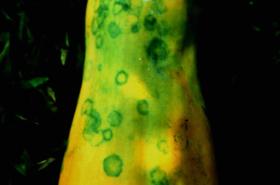
Papaya ringspot potyvirus (PRSV) on papaya fruit
© A.A. Seif, icipe
- AIC (2003). Fruits and Vegetables Technical handbook. Ministry of Agriculture and Livestock
- Beije, C., Kanyagia, S. T., Muriuki, S. J., Otieno, E. A., Seif, A. A., Whittle. A. M. (1984). Horticultural Crops Protection Handbook. National Horticultural Research Station, Thika, Kenya.
- CABI (2005). Crop Protection Compendium, 2005 Edition. © CAB International Publishing. www.cabi.org
- De Villiers, E. A. (1999). The Cultivation of Papaya. Institute for Tropical and Subtropical Crops. Published ARC.LNR. South Africa.
- De Villiers, E. A., Willers, P. (1995). Papaya pests. In Papaya. Institute for Tropical and Subtropical Crops. Published by the ARC. South Africa.
- EcoPort: Information on Ethnobotany: www.ecoport.org
- GTZ-Integration of Tree Crops into Farming Systems Project (2000). Tree Crop Propagation and Management - A Farmer Trainer Training Manual. BMZ/GTZ/ UNEP/ Ministry of Agriculture and Rural Development Kenya.
- Griesbach, J. (1992). A guide to propagation and cultivation of fruit trees in Kenya. GTZ. Germany. Schriftenreihe der GTZ, No. 230. ISBN 3-88085-482-3.
- Horticultural crops protection handbook. National Horticultural Research Station, Thika. Keny170 pp.
- Kessing, J.L.M. and Mau, R.E.L. (1992). Brevipalpus phoenicis (Geijskes), Red and Black Flat Mite. Crop Knowledge Master. Department of Entomology. Honolulu, Hawaii. www.extento.hawaii.edu
- Nutrition Data www.nutritiondata.com.
- PIP Technical Itinerary Papaya. www.coleacp.org/en
- Papaya. Export Manual. Tropical fruits and Vegetables. Protrade, GTZ
- Pests of papaya. Broad mite in papaya. Department of Primary Industries and Fisheries. Queensland. David Astridge,. Last updated: December 2003. www2.dpi.qld.gov.au